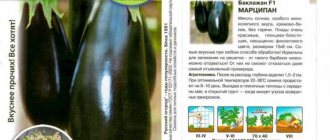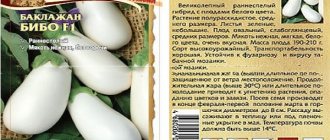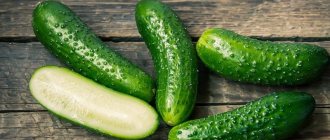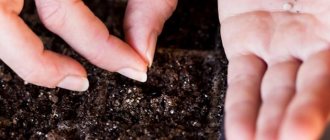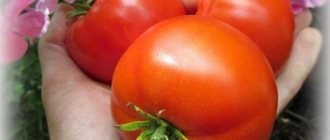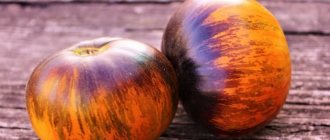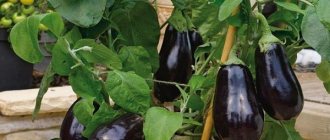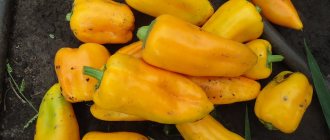Description of the variety
Eggplant A gardener's dream has a lot of advantages, including:
- high productivity;
- disease resistance;
- excellent taste of fruits and ease of care.
Ripe eggplants are used in home cooking, canning and processing. The harvested crop, even during long-term transportation, does not lose its taste and presentation.
Landing
The planting period begins in mid-February. Seeds are prepared for sowing. To disinfect, they are kept for about half an hour in a solution of potassium permanganate or peroxide. You can use Fitosporin or Acrobat for treatment.
The seedlings are kept warm (23-27 degrees) until the seedlings germinate.
The appearance of loops occurs after 5 days if prepared seeds are sown. When planting dry seed material, sprouts will appear on the surface after 10-12 days.
For seedlings, you can use boxes and then plant the bushes into separate cups. It is convenient to immediately plant the seeds in 250-300 ml pots; in this case, picking is not required. The optimal height of the sides of the containers is 10-12 cm. Use loose soil with a neutral pH.
Care
In order to get a good harvest, you need to follow several rules.
Watering
It is necessary to moisten the soil with settled warm water. Water 1-2 times a week until flowering. 10 liters of liquid are consumed per 1 m2.
Expert opinion
Filatov Ivan Yurievich, private farmer for more than 30 years
With the beginning of flowering and fruiting, watering is carried out at the root. If it is not possible to moisten the soil once a week, then the water consumption rate will have to be increased.
Temperature
Gardener's Dream eggplants develop well at an air temperature of 23-26 degrees, so it is not recommended to allow them to freeze or overheat; to protect the plants from the cold, you must use film or agrotextiles. During periods of extreme heat, it is better to build light shading. Then the plants will receive protection from burns.
There is also eggplant, which is also very sensitive to temperature changes. In this article, you can find out when is the best time to start planting seedlings of the Maria variety, and see what it looks like when grown in a greenhouse.
Pinching
As soon as the length of the shoot is 30 cm, pinching can be done. The essence of this procedure is to remove the top of the bush. Leave 5-6 healthy and strong side shoots, the rest will have to be removed. Stepping may not be carried out if the summer is very hot and dry.
Loosening the soil
Once every 7 days it is necessary to loosen the soil to prevent clumping. This process should be combined with weeding. If there are weeds, they will create many problems by attracting pests, so it is necessary to deal with them in a timely manner.
How often do you think eggplant seedlings need to loosen the soil?
Once a day Once a week
Top dressing
During the entire growing season, fertilize at least 3 times a day:
- Apply food for the first time 20 days after planting the seedlings.
- Fertilizers are applied a second time after 3-4 weeks.
- The third time to use the food is during the fruiting period.
Eggplants are a gardener's dream and need mineral fertilizers, including:
- superphosphate;
- nitrophoska;
- ammonium sulfate;
- potassium nitrate.
Potassium nitrate
In addition, the following home remedies are popular:
- Pour 2 liters of boiling water over a glass of dandelions, cover with a lid and leave for 3-4 hours. Dilute 7 liters of water and use for root feeding.
- Take 200 g of chamomile, pour 1 liter of boiling water, leave for 1 day and dilute with 9 liters of water before use.
- Finely chop eggshells, pour in 10 liters of water, wait 2 days, and then use for watering.
Growing eggplant seedlings A gardener's dream
Depending on climatic conditions, it is permissible to grow the crop both from seeds and by planting. But still, the second method is more preferable for most regions of our country.
Features of sowing seeds
You can start sowing seeds, taking into account favorable days for this process. You can track specific dates in the current year using the Lunar calendar, but on average they fall at the beginning of March.
It is important to properly prepare the seeds for sowing so that they sprout well and in the future you can grow the required number of seedlings:
- Be sure to soak the purchased planting material in a weak solution of potassium permanganate to disinfect it.
It is enough to keep the seeds in the liquid for 25-30 minutes, then rinse with clean water.
- Immerse them in a special solution for 24 hours to stimulate growth. Nitrophoska, diluted with warm water, works well.
- Sprout before immersing in soil, leaving them for a day on damp gauze or a towel at a temperature of about +30⁰C.
After the seed has been prepared as described above, you need to take soil consisting of equal parts of sand, turf soil and peat and pour it into the selected container for growing seedlings. You can use a small box made of plastic or wood, or special containers that are divided into small cells, as well as separate small cups.
The seeds should be placed in the soil to a depth of 1-2 cm, sprinkled with a thin layer of substrate on top.
When sowing in a common container, you need to maintain a distance of 5 cm between the seeds so that when planting it is easy to remove the sprouts along with the soil. After completing this procedure, the pot or container should be covered with film to create a microclimate for sprouting.
Photo
You can learn more about what the vegetable crop looks like and what distinguishes it from other varieties of eggplant by studying the following photos.
The Gardener's Dream variety is a high-yielding and early-ripening eggplant variety that is suitable for growing in open and closed ground. It resists major diseases, is undemanding in terms of care and produces tasty fruits.
Transplanting seedlings into the ground and further care
In order to obtain the high yield declared by vegetable producers, it is necessary to properly care for it throughout the entire period from sowing to harvesting.
Preparation for transplantation and hardening
The readiness of young sprouts for planting should be determined by the presence of leaves on them. In order for a small bush to take root and continue its growing season on the stem, there must be at least 2, and preferably 4-5 leaves. These seedlings are suitable for planting in a greenhouse or garden bed.
It is important to harden seedlings that will grow in the garden, because the Gardener's Dream variety is not frost-resistant and does not tolerate temperature fluctuations. In order to prevent plants from dying or stopping their development when it decreases, you should start hardening them a month before planting in open ground.
It is necessary to open the window for ventilation for 10-15 minutes every day, but make sure that the air temperature in the room is not lower than +15°C. In this way, the seedlings will be prepared for natural conditions.
Transplantation into the ground
You should carefully choose the place to plant this crop, since it is quite whimsical. The soil should have a neutral pH level, the area should have good lighting. There should be no drafts here, which can be achieved by planting bush plants nearby that can protect the eggplant from the winds.
Important!
Tomatoes and potatoes are undesirable neighbors for vegetables, but cabbage, cucumber and onions are acceptable.
It is advisable to transplant in the evening or in cloudy weather, after moistening the soil. Plants should be located at a distance of up to 30 cm from each other, so that in the future the bushes can form and grow. Seedlings should not be planted deep.
Try to carry out the process without disturbing the root system and preserving the soil around it as much as possible. This way the plant will not experience stress from being moved. After planting, the seedling must be watered with settled water, the temperature of which is not lower than street or greenhouse temperature.
Watering
Since the vegetable is moisture-loving, it needs to be watered regularly and thoroughly, using settled water, the temperature of which is as close as possible to warm. The plant should be moistened at least 2 times a week before flowering, and during the period of ovary and fruiting, be guided by weather conditions. When the temperature rises above +25°C, additional watering should be done.
You should not flood the bushes, since moisture collected at the stems will lead to rotting of the roots.
Fertilizers
You may be interested in: Favorable days for planting eggplants in the Urals and Siberia in 2021. Dates for planting eggplants for seedlings in 2021 according to the lunar calendar of the gardener. Picking eggplants for seedlings according to the lunar calendar 2021
Even in the presence of fertile soil, it is recommended to fertilize eggplants. Application scheme:
- 20 days after planting the seedlings, both ash and complex growth products from stores are suitable;
- re-application 3 weeks after planting. You can use any organic fertilizers, as well as potassium, nitrogen, phosphorus, based on the condition of the plants;
- Once or twice during fruit ripening, it is important to apply potassium and phosphorus fertilizers.
Experienced gardeners apply products made from herbs and available substances. Popular fertilizers are made from dandelions, chamomile, and eggshells.
Diseases and pests
Since the variety in question was originally introduced as resistant to various kinds of diseases to which nightshade plants are susceptible, we can say that it is completely protected from them. This eggplant does not suffer from common late blight and anthracnose.
It should be noted that insects also rarely choose plant bushes due to their specific composition.
But the Colorado potato beetle can appear on the leaves and stems of the vegetable; it should be treated with any poison intended for this pest.
If a mole cricket appears on the site, it can also infect the roots of the eggplant. Loosening the soil and adding special poisons or organic folk remedies (soap solution, chicken droppings) allows you to cope with the insects.
Seed preparation
Gardeners claim that many diseases can be prevented if the seeds and soil are treated with a disinfectant solution before sowing. Use potassium permanganate and ash:
- From the total number of seeds, it is necessary to select high-quality material. To do this, they are immersed in water and left for 30 minutes. Those seeds that float are subject to discarding;
- the remaining ones are washed well and kept in cold melt water or saline solution. These manipulations are necessary in order to “awaken” the seeds;
- then the treatment is carried out in a thick solution of potassium permanganate; stand for 30 minutes;
- After disinfection, the seeds are saturated with vitamins. To do this, use corn or potato starch, whey; lactic acid bacteria destroy pathological microflora;
- drugs from the manufacturer are used as a growth stimulator. Gardeners often use Epin. It contains vitamins and mineral salts.
More on the topic: What characteristics does the Nutcracker eggplant have?
After the preparatory period, the seeds must be germinated. If there are a lot of them, then use a large shallow container. A tray is often chosen. Small holes are made in the bottom part.
Place the seeds on a tray, spray them with water and cover with a napkin. To keep the seeds constantly moistened, the tray can be placed on a basin of water.
View this post on Instagram
Posted by Marigreen (@mari_green_flower)Mar 15, 2021 at 9:22 am PDT
If there are few seeds, they are wrapped in a damp cloth. The optimal temperature for germination is 14 C. For the eggplant Gardener's Dream, the preparatory period is very important.
Planting is carried out after the seeds have “hatched”. They are not allowed to ripen until large sprouts form. When planting, the shoots may break; there will be no shoots.
Characteristics of the variety
Productivity and fruiting
Eggplant of the Gardener's Dream variety is characterized by abundant yield. In spring and summer, about 6 kg per 1 m2 can be collected from a plant. The crop begins to bear fruit 3-3.5 months after the first shoots.
These vegetables are quite demanding on lighting. For example, a 16-hour daylight hours will provide the plant with active growth, but the fruits will not form. The ideal option is a 12-hour daylight hours, which guarantees the largest harvest volumes.
Area of application of fruits
Eggplant is a versatile vegetable. It can be consumed in a variety of states other than raw. The fruits can not only be boiled, stewed and fried, but also pickled. Eggplants make excellent cold and hot snacks. Some even use the vegetable to make vegetarian kebabs. The most popular dishes that use these fruits are stews, caviar and pancakes.
Resistance to diseases and pests
This variety of eggplant is resistant to diseases such as anthracnose and late blight, which often affect other types of crops. This allows you to grow the plant without resorting to chemical treatments. Among insect pests, Colorado potato beetles can be a gardener's dream. To overcome them, you need to use the drug “Confidor” or catch the parasites manually.
Advantages and disadvantages of the variety
Eggplant of the Gardener's Dream variety has many positive qualities, which include the following characteristics:
- large volume of harvest;
- quality and taste of fruits;
- resistance to anthracnose and late blight;
- excellent presentation;
- tolerance of long-term transportation;
- resistance to sudden temperature changes;
- predisposition to long-term storage.
This variety also has negative sides, but in comparison with its advantages there are not so many of them. These include:
- susceptibility to attacks by Colorado potato beetles;
- need for long-term lighting;
- poor frost resistance.
By following the basic rules of crop care, summer residents do not even notice these shortcomings, as they claim in their reviews of eggplants of the Gardener’s Dream variety.
Soil preparation
While the seeds are ripening, it is necessary to prepare the soil for sowing. You can take soil from the garden. It is recommended to bake it in the oven to prevent the development of pathological microflora.
If the soil is hard, then peat, sand or vermiculite are added to it. Take 1 part of soil from the garden, 1 part of vermiculite and the same amount of peat.
The soil is kept in a warm room. For sowing, use soil at a temperature of 25 C. It should be loose and soft. Before sowing, it is irrigated with an ash solution. Take 0.5 kg of ash per 5 liters of water and leave for 12 hours. The solution is filtered and the soil is irrigated with a spray bottle.
For better growth, biostimulants are used. You should always study the instructions for their use. High concentrations can destroy seeds.
For planting, it is recommended to choose peat pots. Plants develop in it before planting in the ground. When planting, the pots are not released; they are lowered into the hole along with the plant. If there are a lot of seeds, then sowing is done in boxes. In this case, it is necessary to dive the seedlings into the greenhouse.
More on the topic: Why don’t eggplants set?
